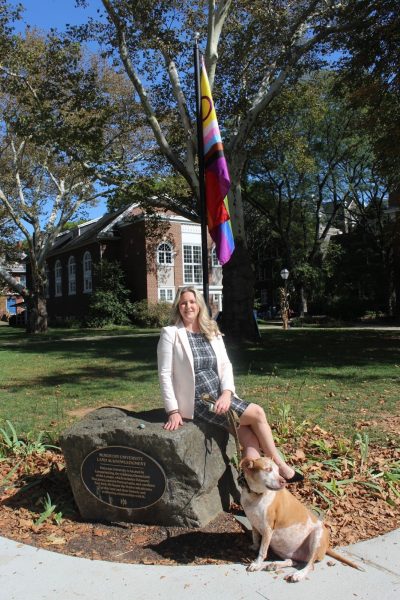Recontextualizing Religion: A Biblical Case for Inclusion
Trigger Warning: Mention of Rape
On a forum held by The Office for Diversity, Inclusion, and Equality (DEI) and The Office for Spirituality and Inclusion, Rev. Laura Oesterle, assistant chaplain, initiated an informative session detailing and debunking Biblical scriptures that have been used against the LGBTQ+ community.
The forum, which was held on Friday, September 30, also invited participants to comprehend the ways in which the Bible has been misinterpreted to feed into invalid, bigoted rhetorics.
When it comes to the discussion of same-sex relations in connection to the Bible, men are primarily discussed. According to Oesterle, “Women were not on the radar or were not included in the Bible that much.” She elaborated on this statement by noting that this instance has much more to do with societal gender roles than gender identity. Additionally, she clarified that when it comes to the discussion of “sex” in the conversation of Christianity, there was the conservative belief that sex need only be for procreation.
Homosexuality was not coined until 1865 through 1892; before this period, there was no name for it. In fact, the word would not appear in the Bible until 1946 due to the choice of translators. When it came to the Bible, Oesterle first invited the audience to consider the story of Sodom and Gomorrah as detailed by Genesis 13 and 18.
Sodom and Gomorrah were neighboring cities of the Dead Sea and the people of Sodom were considered sinners. Prophet Abraham and Sarah take in two angels disguised as strangers, an instance that revolves around the lesson of hospitality.
Abraham’s nephew Lot takes in the same angels that Abraham took in but is met with a wicked mob of men wanting to have homosexual relations and rape the strangers. However, Lot offers his virgin daughters instead to not violate his guests, problematically prioritizing ritualistic culture over his own daughters. In the end, the angels blind the mob and the two sinful cities are destroyed.
Oesterle explains that the Bible does not agree that the sin of Sodom is not connected to homosexuality, rather, the raping of men by other men was done out of aggression and power dynamic instead of desire or lust. There was no metric when it came to defining specifics with terms like desire, lust, love, monogamy, or commitment.
The discussion then veered onto The Book of Leviticus, citing the infamous 18:22 and 20:13. For those who don’t know, 18:22 indicates “You shall not lie with a male as with a woman; it is an abomination,” and 20:13 cites “If a man lies with a male as with a woman, both of them have committed an abomination; they shall be put to death; their blood is upon them.”
Oesterle debunked these verses by stating that since the verses have much to do with the Old Testament, Christians are not meant to follow the Old Testament laws since Jesus fulfilled those laws through sacrifice; in essence, Christ is at the end of the law.
Oesterle turned our attention to the Pauline Epistles of Romans from the New Testament, specifically 1:26-27 denoting the nature of lust.
There are no specific associations to the deadly sin of lust and there is a larger emphasis on the argument of love instead. In general, the verse is centered more on sacrilegiously turning away from God and reverting to other idols.
We also turned to Corinthians 6:11 which designated that the unrighteous shall not inherit the kingdom of God. The “unrighteous” is never specified beyond the ambiguity of sinners. In some versions of the Bible, the word “malakoi” is used, often meaning soft and effeminate, but does not often appear in the New Testament. Therefore, it is not really an indicator of same-sex “sinners.”
Other words used include buggers, sodomites, and, finally, homosexuals in the 90s standardized versions. However, these terms fall under purposely mistranslating to feed into homophobic rhetoric.
Conclusively, the discussion winded down with a viewing of the trailer for the documentary, “1946: The Mistranslation That Shifted A Culture”. This trailer highlights how the mistranslation indicating that homosexuals shall not inherit the kingdom of God led to 60 years of bigoted expressions and the negative associations between Christianity and the LGBTQ+ community.
It wasn’t until a reader under the pen name David S. decided to contact the translators and point out such a grave mistake. However, it was already too late since the word “homosexual” had already been published and printed in newer Bible versions.
Having the word be used in such a negative context heavily influenced the rhetoric that people functioned under and made it so that queer Christians would be ostracized and alienated. In a word, the mistranslation altered an entire culture and enforced ill-willed ideologies on LGBTQ+ individuals.
In more recent times, there have been attempts to create inclusive Bible versions. These newer versions take into account the relevancy of the LGBTQ+ community in recent times and adapt to queer rituals. Some resources listed where you can read more about this include “God and the Gay Christian: The Biblical Case in Support of Same-Sex Relationships” by Matthew Vines and “The Gospel of Inclusion: Reaching Beyond Religious Fundamentalism to the True Love of God and Self,” by Carlton Pearson.








Barbara Thomson • Oct 17, 2022 at 1:16 pm
It is also worth pointing out that plenty of other things we ignore today were called “abominations”, like touching the skin of a dead pig. Guess all the football players are in big trouble! There are actually at least 60 things in the Bible called “abominations”. Why do people ignore those and focus on only one? And ignore plenty of other directives, like adulterers should be stoned to death? That would certainly cut down on the size of the general population.